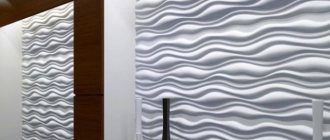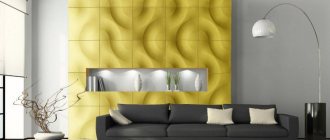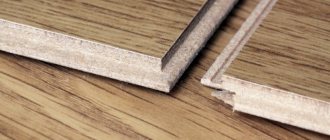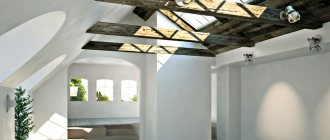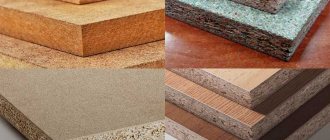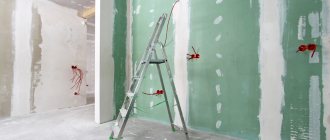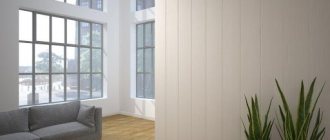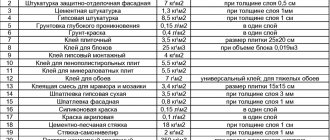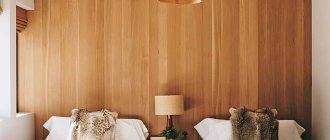Wood building materials are represented by lumber and wood composites. Composite wood products are divided into two large groups:
- laminated wood (from parts with undisturbed wood structure, veneer);
- materials based on wood, crushed to one degree or another.
The most famous representative of the second group is particle boards (chipboards). What is better for furniture, MDF or chipboard? Since the end of the 20th century, the popularity of products made from wood fibers - fiberboard - has been growing. These include MDF, HDF and LDF.
Also read about the differences between MDF and chipboard.
Wood-fiber materials are used in automobile, carriage, shipbuilding, furniture, carpentry and, of course, construction. In response to the growth of these industries, the production of panel materials is also increasing.
About terminology: what are HDF and MDF - decoding of abbreviations, what are the differences and differences
Fiberboard refers to all products made from fluffed wood, regardless of their density. But fiberboard is also often referred to as a specific type of wood pulp product.
This is one that is characterized by low (or rather, not increased) density. The reason for the ambiguity of one term obviously lies in the production process.
The technology for manufacturing loose slabs is the simplest: the stage of forming the “body” of the product is limited to drying the molding mixture on a fine metal mesh.
Denser slabs are, strictly speaking, a modification of conventional ones. The manufacturing process for them is somewhat complicated. Therefore, probably, MDF and HDF have separate names, while the loose ones have a common name. It is convenient if, when talking about loose fiberboard, they add: “low density”, “insulating”, “light” or “obtained by dry method”.
MDF, what kind of material is it? There is another trend: all fiber boards are called MDF .
Perhaps the reason is the popularity of products that are compacted, but not too much, with an optimal price-quality ratio, with the widest possible application.
Differences between HDF boards and others
The main differences are in the technical characteristics of the plates. HDF has a high density compared to analogues, wear resistance, and several sheet thickness options. In terms of its technical characteristics, HDF can be compared to natural wood.
If you compare a sheet with fiberboard, the main differences are that fiberboard cannot withstand heavy loads and, under the same pressure, will deform, crack or break into 2 parts.
If compared with MDF, they will have different areas of application. The thickness of MDF is much larger and is 40-50 mm, while the maximum width of HDF is 6 mm.
HDF, fiberboard and MDF are used for the manufacture of different products, so it is not entirely appropriate to compare them according to their characteristics.
HDF is used more in furniture production, making doors and floors. MDF is more used for decorative work and furniture making.
Manufacturing of fiberboard
Main components of fiberboard:
- wood;
Wood
- binders - polymer or mineral.
The slabs are formed after fluffing the wood to a fiber state. Such fine mechanical grinding is not possible without first cutting and softening the wood (with hot water or steam).
Fluffing is one of the ways of porousization of a material (that is, the inclusion of very small voids evenly distributed throughout the volume into its body). Relatively dense raw materials (sawdust, shavings, wood chips, slabs) after fluffing become fibrous material.
Forming of products begins with mixing a mass of wood fibers with water and additives (fire retardants, antiseptics, water repellents). The raw material suspended in water is poured onto the fine copper mesh of the casting machine.
After the water is filtered (this process is accelerated by a vacuum unit), a carpet of wet fiber remains on the mesh.
The next stage of board production is different for light fiberboard, MDF and HDF:
- to create a soft, low-strength, highly porous slab, the fiber is only dried (in a roller dryer);
- the result of compaction on a hot press (t = 150–165 °C, p = 1–5 MPa) is a fine-fiber material and, at the same time, hard and durable: medium- and high-density fiberboard.
The difference in density and physicochemical properties of solid slabs is achieved by changing the hot pressing time. Soft and semi-hard slabs are lightly pressed, and final drying occurs without compaction.
The same mass, completely dried under high pressure, becomes a solid finishing fiberboard. When making superhard slabs, the suspension is enriched with phenol-formaldehyde polymer (synthetic resin) before dehydration.
HDF composition
HDF board - what is it? The product, reminiscent of hardboard, was first made in 1898 in England using the method of hot pressing waste paper. At the beginning of the last century, material of relatively low density was produced in Canada. In the early 1920s, an improved method of compressing wet wood at high temperatures resulted in significant elasticity. The HDF board manufacturing process is a combination of natural wood fibers and synthetic polymer resins used for bonding purposes. These substances are mixed and then formed in a dry environment, using high heat and pressure to turn the mixtures into individual panels. This manufacturing method helps to bond elements together while maintaining uniform density and compositional structure. Wet processing does not provide high density HDF boards.
Types of fiberboard produced
The mechanical and performance qualities of wood composites significantly depend on their density (ρ). The greater the weight per unit volume, the higher the strength and rigidity of the material.
Depending on density, hardness and weight, wood fiber boards are divided into types by state authorities and manufacturers - if they rely on technical specifications when producing products.
The most common gradation is:
- light fiberboards are those boards whose density does not exceed 500 kg ⁄ m3. They are divided into semi-hard (ρ = 400–500 kg ⁄ m3) and soft (ρ < 400 kg ⁄ m3);
- soft fiberboard, in turn, can be insulating and finishing (ρ = 250–400 kg ⁄ m3) and insulating (ρ < 250 kg ⁄ m3);
- medium density fiberboards (MDF) have a density of 600–800 kg ⁄ m3;
- A density of 800–950 kg ⁄ m3 is considered high, such slabs are called solid (aka HDF);
- a cubic meter of super-hard fiberboard weighs more than 950 kg (usually up to 1100–1200 kg) and has increased water resistance.
Light MDF may be included in a separate group - ρ = 200-600 kg ⁄ m3.
The range of fiberboard density values may be divided differently, for example:
- 600–800 (ldf);
- 750–950 (mdf);
- > 950 (HDF).
In Austria, fibreboards have been developed and are awaiting the start of industrial production, the density of which changes in waves in volume. The strength of such plates is higher than that of homogeneous products with the same thickness and average density (and, accordingly, the same weight).
From hard slabs:
- form partitions;
Partition
- ceilings are hemmed. Here about finishing the MDF ceiling;
Ceiling
- lay floors;
Floors
- make doors;
Doors
- built-in furniture.
Built in furniture
Walls and ceilings are lined with finishing products.
Insulating fibreboards form a heat- and sound-insulating layer of walls and ceilings, and an underlying layer in the floor structure.
These are soft and semi-hard, with the lowest bending strength of the slab. The use of insulating fiberboards is especially widespread in prefabricated panel construction.
For more information about MDF and HDF, watch the video:
Where are HDF boards used?
Due to their characteristics, the boards are used in many industrial fields.
The furniture industry is the widest area where HDF is used. Hidden parts of furniture structures are made from them - the back walls of furniture, cabinets, screens. They make inserts in cabinet and upholstered furniture.
Thanks to this, the price of furniture becomes lower. They make bases for kitchen countertops and splashbacks, exhibition stands and much more. Perforated HDF room partitions, open storage systems and even decorative screens for indoor radiators have become very popular.
Also, when decorating an HDF sheet, it can be given the appearance of any wood - this is how wall panels and various floor coverings are made.
Repair work . HDF is often used in rough work when renovating apartments, houses and other premises - making a rough floor, leveling walls, sewing up communications, and is used in complex structures for suspended ceilings.
Door production . Interior doors are made from HDF sheets. The quality and technical characteristics of such doors are not inferior to solid wood doors, and their price is much lower.
Used for lining vehicles - cars, train cars, buses. They are used in many other areas and directions - they make picture frames, containers for non-food products, various types of packaging and much more.
Material characteristics
Product dimensions
Finished products are obtained after cutting dry wood fiber carpet into slabs. The length of the slabs is 1.2–12 m, width 0.6–2 m. Thickness depends on hardness :
- 3–8 mm - hard;
- 8–25 mm (38 mm - “Extra Light”) - insulating.
Dimensions
There are no fundamental differences in the dimensions of MDF and HDF.
Soundproofing
To isolate the room from sound propagated by shock transfer, the structures of the internal walls of interfloor ceilings are provided with a cushioning layer of sound-proofing material.
The porous-fibrous structure allows fluffed wood materials to act as a sound insulator.
Soundproofing material
But only those fiberboards that are called insulating are effective in absorbing impact noise. MDF and HDF are too rigid and not deformable enough to dampen the vibrational movements of the structure caused by the sound wave.
As insulation for doors
To rightfully be called a thermal insulation material, the thermal conductivity of fiberboard should not exceed 0.175 W / (m × °C) . Only soft fiberboard can serve as an organic fibrous piece heat insulator - with parameters in a dry state:
- ρ avg. = 0.15–0.35 t ⁄ m3;
- thermal conductivity - 0.064–0.1 W ⁄ (m × °C).
Insulation
Such products can cover a wall, ceiling, cover a floor, insulate a roof, or a loggia. Here is the installation of MDF ceiling.
In sandwich panels
Fibreboards with sufficient rigidity - MDF and HDF - can serve as cladding for flat three-layer structures with a polymer core of heat and sound insulation.
Lightweight fiberboards are used as an outer layer, not for structural purposes, but for insulating multilayer products, with polyurethane foam in the middle.
Thanks to the qualities of the fibreboard (only a few millimeters thick), covering both sides with a light and fragile layer. Wall panels for interior decoration have good physical and mechanical properties. By changing the thickness of the outer layers, manufacturers vary the strength of the entire product.
Sandwich panel
In public and industrial buildings, sandwich panels are used to insulate external walls and partitions, and they are used to form suspended MDF ceilings. For residential premises, polymer material, even hidden in the casing, is not suitable: it is flammable and toxic.
An alternative to synthetics is honeycomb core (cardboard, paper). Its advantages include safety and the ability to increase the thickness of the product without adding weight.
Corrugated strips of three-layer plywood, profiled solid wood bars inside HDF sheathing are heavier than other cores, but do not impart carcinogenic properties to the product. Are the substances that bind wood fibers together harmless?
Migration of formaldehyde
fiberboard is the most popular material for the manufacture of furniture, interior doors, baseboards, trim, and other items used inside residential premises. Here about the laminated MDF plinth. What solid wood cannot boast of, but which is typical for fiberboards:
- homogeneity – identical properties throughout the entire volume of the product;
- relatively light weight;
- lower heat and sound conductivity.
MDF and HDF differ from particle boards by more than half the content of synthetic resins. The concentration of formaldehyde in fiberboard, according to the domestic standard, should not exceed 8 mg ⁄ g of an absolutely dry board. But this figure significantly exceeds Western European requirements.
Chipboards have gained fame as a building material with increased toxicity . The problem with particle boards is the migration of poisonous formaldehyde gas from them. Limiting carcinogen emissions from products by state standards did not eliminate the problem.
180 domestic enterprises surveyed by the State Sanitary and Epidemiological Supervision Service and the Forest Products Certification Center produce board materials that emit formaldehyde significantly exceeding the maximum permissible values.
Domestic manufacturers of board products need to reduce the content of harmful resin, change its type, and improve production technology. In terms of formaldehyde concentration, HDF and MDF boards are not fundamentally different from each other.
The intensity of its release into the atmosphere, obviously, depends on the density of the wood-fiber material (then HDF is better than MDF). But this difference is hardly so significant that it should be taken into account as a difference between these types of fiberboard.
Application of panels
Thanks to its excellent parameters, the area of use of HDF boards is quite wide:
- Furniture manufacturing. The product is gradually replacing hardboard, because it can be used as the back wall of interior items, the bottom of drawers and inserts of frame and MDF facades. A special technology makes it possible to produce radius parts.
Furniture made from high-density boards lasts longer - Wall covering. Unlike other wood panels, products with a thickness of 3 mm are used for the manufacture of wall panels, which significantly expands the scope of activity. Such finishing can imitate various materials with high reliability. Due to the dimensions, it is possible to cover large areas at once, reducing work time. Laminated HDF is suitable for cladding balconies and other unheated rooms
- Production of kitchen aprons. The selected image is applied to the panel using photo printing. The material is also used for heating radiator screens: shaped holes are cut out, which ensures free air flow. Resistance to humidity allows the product to be used in finishing kitchen aprons
- Making doors. Wooden panels are glued onto a honeycomb frame, forming the front surfaces. Most often, such products are classified as “economy” segment. The fact is that the top coating is a laminated or laminated layer.
Overlays made of high-density material can be mounted on entrance doors from the street side - Indoor work. HDF is excellent for roughing out when laying laminate or parquet, as well as for preliminary leveling of wall and ceiling surfaces.
- Interior decoration of carriages, car interiors and even airplanes. Light weight and high strength ensure resistance to various impacts.
HDF is not afraid of vibration, therefore it is widely used in vehicle interiors.
The material is also used as spacers when transporting goods, to create shaped elements and the basis for Hand Made.
Decorative finishing of fibreboards
Coatings protect the slabs from moisture and abrasion :
- enamel. The products become the most moisture-resistant, suitable for cladding the walls of grocery stores and medical institutions. Here about moisture-resistant MDF;
Enameled
- polymer films for rooms with high humidity in the bathroom and kitchen. Here about bathroom furniture;
Covered with polymer film
- paper impregnated with resins;
- paint - water-based polyvinyl acetate;
Painted
- plywood.
Plywood
Abrasion of the varnish film occurs to a greater extent on the inside of furniture made of MDF and HDF.
Microclimatic factors (mainly the difference in humidity that accompanies the change of seasons) affect wear and tear 3–4 times less than the use of the contents of cabinets and chests of drawers.
However, the coating on the back side of furniture is thinner than on the front side. Lamination of slabs with synthetic film is carried out on textured paper that imitates the cut of solid wood of a valuable species. This is how laminated wall panels are made.
Installation of a kitchen apron made of HDF panel, care features
If we talk about the method of fastening, then everything is extremely simple. HDF panels can be installed on an aluminum profile or a wooden frame. Liquid nails can serve as fastening to the wall. Installation is carried out in the same way as installing plastic or MDF panels.
It is important to note that you can use self-tapping screws or nails to attach a kitchen apron to the wall only if the surface is perfectly smooth and has been treated with a special antifungal solution.
To reliably install HDF panels, you must first build a frame, and only then fasten the board itself, using, for example, self-tapping screws.
Caring for a kitchen apron made of HDF does not require much effort. It is enough to wipe it with a damp cloth or cloth; use high-quality household products for cleaning. The panel is quite resistant to mechanical damage, so it is not “afraid” of various powder products or in the form of gel and cream. Using abrasive sponges may cause scratches.
With proper and careful care, kitchen aprons made of HDF can last for a long time without losing excellent performance characteristics.
Is the type of wood important in fiberboard?
The microstructure of coniferous and deciduous wood is different. Thus, only deciduous trees have tubes running along the trunk - vessels through which moisture rises from the roots to the crown. But in the trunks of coniferous trees there are intercellular spaces filled with resin (resin passages). The properties of specific breeds also vary.
The performance of most wood composites depends on the properties of the wood from which they are made. For example, the density of chipboard, poplar plywood is 450 kg/m3, birch is 650, and coniferous plywood is 550. Paulownia plywood is 1.7 times lighter than birch plywood.
The properties of products made from wood separated into fibers retain a connection with the species, but less significant. The macrostructure of the initial solid raw material has a weaker effect on the quality indicators of MDF and HDF.
It has been experimentally established that slabs made from coniferous tree fibers are the most durable . The reason for this is the peculiarities of the fractional composition of wood pulp and the shape of the particles. As for specific hardwoods, birch MDF and HDF are stronger than others, alder and aspen are “weaker”.
The inclusion of deciduous wood in the raw composition of a building material is fraught with a decrease in its physical and mechanical characteristics. Density and swelling are almost not affected, and the bending strength is reduced.
Advantages and disadvantages of panels
The main advantages of HDF include:
- homogeneity of the material, absence of voids and any compactions;
- harder surface and increased density;
- resistance to abrasion and aggressive substances;
- perfect size fit;
- ease of technical processing;
- good sound insulation;
- resistance to corrosion and fungi;
- excellent strength;
- ease of care;
- affordable price.
The disadvantages of HDF boards are insignificant. In damp and humid environments, the material is not endowed with sufficient moisture resistance. To solve this problem, it is enough to cover the panels with special profiles at the ends and at the joints using silicone glue.
MDF material is characterized by the following advantageous features:
- environmental friendliness, naturalness;
- ease of processing;
- good moisture resistance;
- hygiene, versatility;
- resistance to corrosion and fungi;
- safety at home;
- good heat and sound insulation;
- acceptable price.
The main disadvantage of MDF board is its low strength. Another drawback of this material is flammability. Therefore, in order to avoid short-circuiting the electrical wiring in the event of a fire, it is necessary to place the wiring under the panels only in a special corrugation.
MDF (Medium Density Fiberboard)
MDF (finely dispersed fraction) is widely popular among consumers in the construction market and has already replaced plastic and ceramic tiles in the back rows. Its benefits have been appreciated by many.
MDF is a board with medium density, the full name is Medium Density Fiberboard, where Medium means “average”. Fine wood shavings are used for its production. But technology does not stand still and develops, bringing new, more advanced materials and methods for their creation.
Not long ago, the building materials market was replenished with a new type - HDF. It is a fiberboard with a higher density. Let's look at how else it differs from other types of materials, and what features it has.
